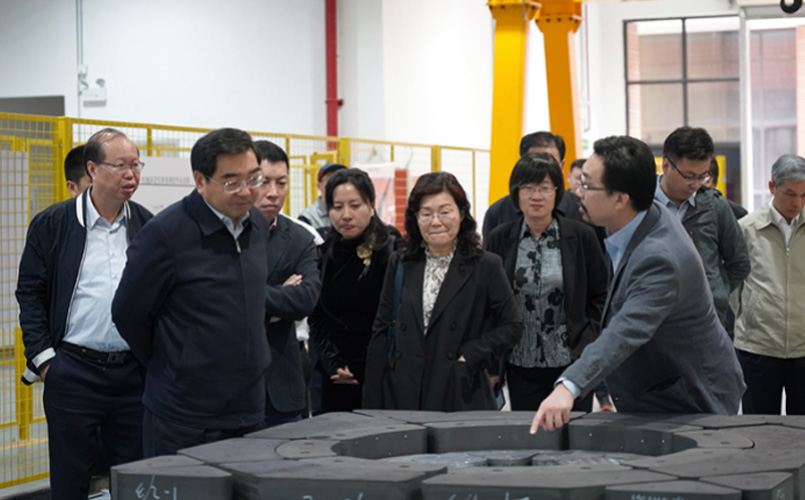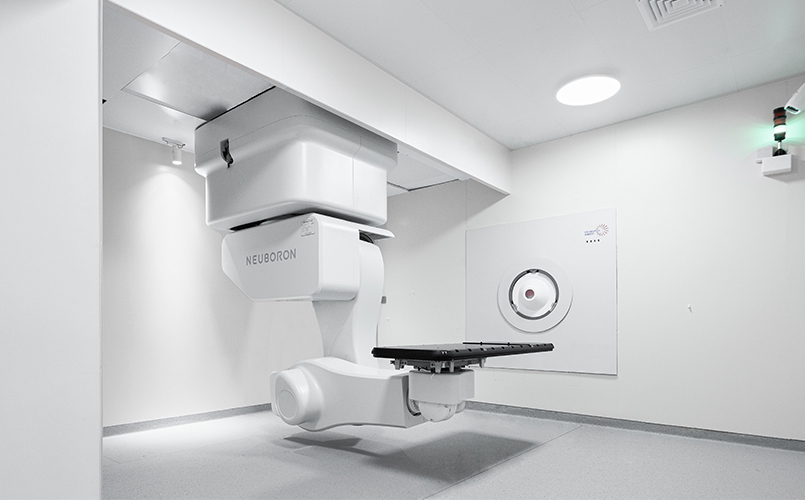On the 5th August 2021, after 24 months construction and installation, the Xiamen Humanity Hospital (XHH) BNCT Center, the first BNCT clinical center as well as an international BNCT research harbor, successfully delivered the 1st batch of epithermal neutron beams that could be used for BNCT irradiation. The leading actor of XHH BNCT Center is the accelerator-based BNCT system, NeuPexTM (Block-I), designed and developed by the Neuboron Medical Group. NeuPex consits of a specially developed Beam Shaping Assembly (BSA), a Patient Positioning System, a Medical User Control System, a solid lithium target assembly, and a low energy proton accelerator (2.5 MeV / 10 mA or higher) which could be powered by an electrostatic machine or an electromagnetic one. The system is now under commissioning and V&V. The XHH BNCT Center will be open to the public (only for research and clinical trial, not yet for clinical treatment) in Spring 2022.

In May 2019, Neuboron and Xiamen Humanity Hospital (located in Xiamen, an island city and a special economic zone in Fujian Province, China), an AAA General Hospital focusing on the treatment of cancer, nerves, ENT etc., launched the construction of the China’s first BNCT Center together. The new building is dedicated to BNCT only.
The compact and well-equipped center covers an area of approximately 1,300 square meters, with two floors underground and two floors above the ground. The center unprecedentedly accommodates a layout of three treatment rooms, with two for horizontal treatment located at Basement 1 and the other for vertical treatment located at Basement 2. The whole core area is only about 800 square meters.
The center defines itself as an international research harbor which aims not only to facilitate BNCT research with Chinese scientists, but also to explore the knowledge of BNCT together with talents and scholars worldwide. Therefore, the center equips with laboratories for medical physics, radiobiology, chemistry, ICP-MS, etc. The harbor will open for visiting scientists in 2022.
The AB-BNCT system “NeuPexTM” has been installed in the building. And more than 50 scientists, engineers, and technicians are still working in the facility marching toward the clinical study. The Xiamen BNCT center is now under commissioning and V&V. It aims to conduct preclinical animal study in the Autumn, and the goal is to perform the first human clinical study by the end of 2021.

NeuPex is a compact AB-BNCT system manufactured for clinical application; it is designed to provide efficient and high-quality epithermal neutron beams with an advantage depth of 11 cm (under a given condition) through a specially developed BSA. The neutron flux is generated from a solid lithium target using a 2.5-MeV proton beam. The Block-I model utilizes an electrostatic accelerator to power the proton beam (nominal current of 10 mA). An evaluation using Snyder phantom and ENDF/B-VII cross-section library shows a short treatment time could be achieved (< 30 minutes) using NeuPex at 2.5 MeV and 10 mA (e.g., 25 kW).
Another important feature of NeuPex is the high-efficiency Patient Positioning System which utilizes two identical sub-millimeter precision robotic arms per set; one is installed in a simulation room, and the other one in the treatment room. The design of 3 pairs of robotic arms and the 3 treatment rooms makes a theoretical capacity of >4,000 irradiations per year which is important for countries (like China) having large and dense populations.

In order to provide a friendly dose calculation environment, Neuboron has developed a TPS (Treatment Planning System) named NeuMantaTM (Neuboron Multifunctional Arithmetic for Neutron Transportation Analysis, NeuManta) which has a built-in dose engine COMPASS (COMpact PArticle Simulation System, COMPASS) and provides support for MCNP and PHITS too. Unlike conventional radiotherapy, the dose engine for BNCT relies on the Monte Carlo method. Thus, the Monte Carlo dose engine COMPASS was developed to provide speedy and accurate dose calculation in NeuManta. The calculation speed is 150% faster than MCNP6 with the same calculation accuracy.
NeuManta is DICOM-RT compatible which could help users to prepare the ROIs on the TPS whichever they are familiar with and shorten the learning curve. NeuManta supports medical images of CT, PET and MRI. The material conversion algorithm of CT images utilizes the HU values to build more authentic voxel materials (up to 96 materials and expanding). The difference between using a simplified material library and the HU-value conversion algorithm could be more than 5%, and such a discrepancy should not be ignored.

Neuboron Medical Group was founded in 2014 focusing on the development of BNCT total solution for hospital users, including a complete set of accelerator-based BNCT system, TPS, theranostic boron or gadolinium carriers (e.g., BPA and F-BPA), as well as facility design and construction. Currently, it has developed its own BPA and F-BPA in China. The F-BPA is currently undergoing clinical study in the famous Peking Union Medical College Hospital using nucleophilic radiosynthesis.
In the past 7 years, Neuboron has not only built a strong BNCT consortium in China covering different aspects of BNCT, but also has a strong research cooperation with the Istituto Nazionale di Fisica Nucleare (Italy) supported by the bilateral national key project. In additon, Neuboron has a business cooperation with the TAE Technologies from USA and its partner Budker Institute from Russia.
Very recently, together with Nanjing University of Aeronautics and Astronautics (NUAA), Neuboron calls for postdoctoral and research fellow positions in both Xiamen and Nanjing Cities for people who are genuinely enthusiastic about BNCT researches at Xiamen BNCT Center. For anyone who is interested in being a visiting scientist or postdoctoral researcher, you are more than welcomed to be our guest in the beautiful BNCT research harbor in Xiamen.



